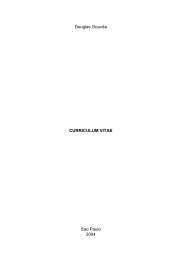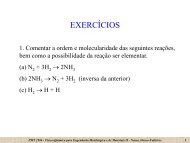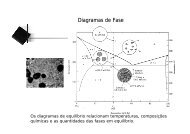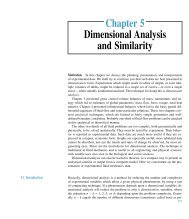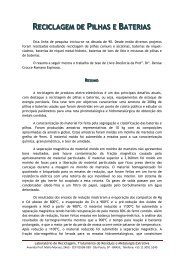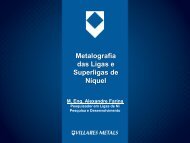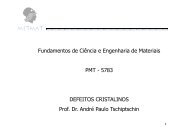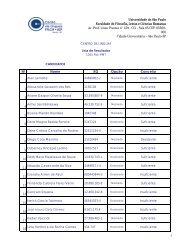The Use of a Vickers Indenter in Depth Sensing Indentation for ...
The Use of a Vickers Indenter in Depth Sensing Indentation for ...
The Use of a Vickers Indenter in Depth Sensing Indentation for ...
You also want an ePaper? Increase the reach of your titles
YUMPU automatically turns print PDFs into web optimized ePapers that Google loves.
Vol. Materials 7, No. Research, 3, 2004Vol. 7, No. 3, 483-491, 2004. <strong>The</strong> <strong>Use</strong> <strong>of</strong> a <strong>Vickers</strong> <strong>Indenter</strong> <strong>in</strong> <strong>Depth</strong> Sens<strong>in</strong>g <strong>Indentation</strong> © 2004 483<br />
<strong>for</strong> Measur<strong>in</strong>g Elastic Modulus and <strong>Vickers</strong> Hardness<br />
<strong>The</strong> <strong>Use</strong> <strong>of</strong> a <strong>Vickers</strong> <strong>Indenter</strong> <strong>in</strong> <strong>Depth</strong> Sens<strong>in</strong>g <strong>Indentation</strong><br />
<strong>for</strong> Measur<strong>in</strong>g Elastic Modulus and <strong>Vickers</strong> Hardness<br />
Adonias Ribeiro Franco Jr. a , Giuseppe P<strong>in</strong>taúde b , Amilton S<strong>in</strong>atora a ,<br />
Carlos Eduardo P<strong>in</strong>edo c , André Paulo Tschiptsch<strong>in</strong> a *<br />
a Dpto. de Eng. Metalúrgica e de Materiais and Dpto. de Eng. Mecânica, Escola Politécnica,<br />
USP, Av. Pr<strong>of</strong>. Mello Moraes, 2463, 05508-900 São Paulo - SP, Brazil<br />
b Dpto. Acadêmico de Mecânica, Centro Federal de Educação Tecnológica do Paraná<br />
Av. Sete de Setembro, 3165, 80230-901 Curitiba - PR, Brazil<br />
c<br />
Núcleo de Pesquisas Tecnológicas, Universidade de Mogi das Cruzes<br />
Av. Dr. Cândido Xavier de A. Souza 200, 08780-210 Mogi das Cruzes - SP, Brazil<br />
Received: January 27, 2003; Revised: January 26, 2004<br />
<strong>Depth</strong> sens<strong>in</strong>g <strong>in</strong>dentation is a powerful experimental technique <strong>for</strong> determ<strong>in</strong><strong>in</strong>g mechanical<br />
properties <strong>of</strong> materials. In this work a computational rout<strong>in</strong>e was developed based on Oliver-<br />
Pharr method <strong>for</strong> measur<strong>in</strong>g a more precise values <strong>of</strong> elastic modulus us<strong>in</strong>g a Fischerscope<br />
H100 - depth sens<strong>in</strong>g <strong>in</strong>dentation apparatus, with a <strong>Vickers</strong> <strong>in</strong>denter. This computational rout<strong>in</strong>e<br />
aims also to measure <strong>Vickers</strong> hardness, as the equipment does not have s<strong>of</strong>tware <strong>for</strong> this purpose.<br />
From <strong>in</strong>dentation data it was possible to determ<strong>in</strong>e <strong>in</strong>itial unload<strong>in</strong>g stiffness, contact depth, projected<br />
contact area, reduced modulus, elastic modulus and <strong>Vickers</strong> hardness <strong>of</strong> materials. <strong>The</strong><br />
validity <strong>of</strong> the rout<strong>in</strong>e was verified analyz<strong>in</strong>g two coat<strong>in</strong>gs and n<strong>in</strong>e bulk specimens with different<br />
elastic-plastic behaviors.<br />
It was verified that the elastic moduli determ<strong>in</strong>ed through the s<strong>of</strong>tware <strong>of</strong> the equipment resulted<br />
<strong>in</strong> great discrepancies when low loads were applied. A good estimate <strong>of</strong> the elastic moduli <strong>of</strong> the<br />
tested materials is given by the developed rout<strong>in</strong>e. For several test<strong>in</strong>g loads, the diagonals determ<strong>in</strong>ed<br />
by means <strong>of</strong> analytical procedure were compared with the same diagonals measured by image<br />
analysis. A good estimate <strong>of</strong> the <strong>Vickers</strong> hardness <strong>of</strong> the above-mentioned materials is given by the<br />
developed rout<strong>in</strong>e us<strong>in</strong>g different test<strong>in</strong>g loads.<br />
Keywords: depth sens<strong>in</strong>g <strong>in</strong>dentation, elastic modulus, <strong>Vickers</strong> hardness, Oliver-Pharr method,<br />
ISE effect<br />
1. Introduction<br />
Load and displacement sens<strong>in</strong>g <strong>in</strong>dentation technique<br />
allows determ<strong>in</strong><strong>in</strong>g mechanical properties at penetration<br />
depths as low as 20 nm, avoid<strong>in</strong>g the substrate effect on the<br />
measurements 1 . <strong>The</strong> possibility to carry out tests <strong>in</strong> so small<br />
scales makes this technique one <strong>of</strong> the tools chosen to characterize<br />
mechanical properties <strong>of</strong> th<strong>in</strong> films, coat<strong>in</strong>gs, second<br />
phase particles and magnetic hard disk record<strong>in</strong>g media<br />
2-4 .<br />
A well def<strong>in</strong>ed <strong>in</strong>denter geometry is required to get well<br />
def<strong>in</strong>ed <strong>in</strong>dentation impressions. A perfect tip shape is difficult<br />
to achieve. Berkovich is a three-sided pyramid, and<br />
provides a sharply po<strong>in</strong>ted tip, compared to the <strong>Vickers</strong><br />
<strong>in</strong>denter, which is a four-sided pyramid and has a slight <strong>of</strong>fset<br />
(0.5- µm) 5,6 . This is the ma<strong>in</strong> reason why three-sided<br />
Berkovich <strong>in</strong>denters are used <strong>in</strong> depth sens<strong>in</strong>g <strong>in</strong>dentation<br />
mach<strong>in</strong>es. However, any <strong>in</strong>denter with a sharp tip suffers<br />
from a f<strong>in</strong>ite but an exceptionally difficult to measure tip<br />
bluntness. Experimental procedures have been developed<br />
to correct the tip shape, <strong>of</strong> both <strong>Vickers</strong> and Berkovich<br />
<strong>in</strong>denters 1, 7-10 .<br />
When tests are carried out with Berkovich <strong>in</strong>denters,<br />
the registered data can be analyzed us<strong>in</strong>g the method pro-<br />
*e-mail: aptschip@usp.br<br />
Article presented at the XV CBECIMAT, Natal - RN, November/2002
484 Franco et al. Materials Research<br />
posed <strong>in</strong> 1992 by Oliver and Pharr 7 , which has its orig<strong>in</strong>s <strong>in</strong><br />
an earlier treatment by Doerner and Nix 11 . Nowadays, both<br />
methods are accepted <strong>for</strong> the analysis <strong>of</strong> the <strong>in</strong>dentation<br />
data by the ISO/FDIS 14577-1 standard 12 . <strong>The</strong> Oliver-Pharr<br />
method consists <strong>in</strong> a series <strong>of</strong> load<strong>in</strong>g cycles to avoid thermal<br />
drift and plastic reversion, while the Doerner-Nix<br />
method uses only a s<strong>in</strong>gle cycle to obta<strong>in</strong> the <strong>in</strong>dentation<br />
data. <strong>The</strong> Fischerscope H100 - depth sens<strong>in</strong>g <strong>in</strong>dentation<br />
mach<strong>in</strong>e uses the latter method, which is less time consum<strong>in</strong>g<br />
and simpler but takes <strong>in</strong>to account only a few data po<strong>in</strong>ts,<br />
lead<strong>in</strong>g to greater <strong>in</strong>accuracy. Moreover, the Fischerscope<br />
H100 uses the constant hardness calibration method 8,13 to<br />
correct the <strong>in</strong>denter tip shape, which is not adequate s<strong>in</strong>ce<br />
work-harden<strong>in</strong>g may happen dur<strong>in</strong>g the test.<br />
<strong>The</strong> Oliver-Pharr method is widely used <strong>in</strong> depth sens<strong>in</strong>g<br />
<strong>in</strong>dentation mach<strong>in</strong>es with Berkovich <strong>in</strong>denter. However,<br />
it is equally applicable to the case depth sens<strong>in</strong>g <strong>in</strong>dentation<br />
us<strong>in</strong>g a <strong>Vickers</strong> <strong>in</strong>denter, with good results as mentioned<br />
<strong>in</strong> literature 8,14,15 . <strong>The</strong> depth sens<strong>in</strong>g <strong>in</strong>dentation<br />
mach<strong>in</strong>e used <strong>in</strong> this work analyzes <strong>in</strong>dentation data us<strong>in</strong>g<br />
a s<strong>of</strong>tware based on the Doerner-Nix method, and uses an<br />
<strong>in</strong>correct area function to describe the <strong>in</strong>denter tip shape,<br />
lead<strong>in</strong>g to overestimated elastic modulus and hardness values<br />
due to ISE effect - <strong>in</strong>dentation size effect 16 . Additionally,<br />
the Fischerscope apparatus s<strong>of</strong>tware does not give<br />
<strong>Vickers</strong> numbers, which are useful to compare with wellknown<br />
data <strong>of</strong> phases and micro-constituents given <strong>in</strong> literature.<br />
<strong>The</strong> present work aims to develop a computational rout<strong>in</strong>e<br />
based on the Oliver-Pharr method <strong>for</strong> measur<strong>in</strong>g more<br />
precise values <strong>of</strong> elastic modulus and to obta<strong>in</strong> <strong>Vickers</strong> hardness<br />
numbers, us<strong>in</strong>g a Fischerscope H100 - depth sens<strong>in</strong>g<br />
<strong>in</strong>dentation apparatus, equipped with a <strong>Vickers</strong> diamond<br />
<strong>in</strong>denter.<br />
2. <strong>The</strong>oretical Aspects<br />
<strong>Depth</strong> sens<strong>in</strong>g <strong>in</strong>dentation technique consists <strong>of</strong> pr<strong>in</strong>t<strong>in</strong>g<br />
an impression on the material surface by apply<strong>in</strong>g a<br />
known load with an <strong>in</strong>denter <strong>of</strong> known geometry and subsequently<br />
analyz<strong>in</strong>g the load vs. displacement data. Equations<br />
from the elastic punch theory can be used to determ<strong>in</strong>e<br />
the elastic modulus, E, and hardness, H, provided that<br />
the follow<strong>in</strong>g conditions dur<strong>in</strong>g the <strong>in</strong>itial withdrawal <strong>of</strong><br />
the <strong>in</strong>denter are ensured:<br />
• the material’s recovery follows an elastic behavior;<br />
• the contact area between the <strong>in</strong>denter and the specimen<br />
rema<strong>in</strong>s constant.<br />
In this case, the Sneddon’s solutions 17,18 <strong>for</strong> the case <strong>of</strong><br />
the <strong>in</strong>dentation <strong>of</strong> an elastic half-space <strong>for</strong> a cyl<strong>in</strong>drical<br />
punch approach to the elastic behavior. One <strong>of</strong> the<br />
Sneddon’s solutions leads to a simple relation between the<br />
load, P, and the penetration depth, h, <strong>of</strong> the <strong>for</strong>m:<br />
where a is the radius <strong>of</strong> the cyl<strong>in</strong>der; µ is the shear modulus;<br />
and ν is Poisson’s ratio. Know<strong>in</strong>g that the area <strong>of</strong> the contact<br />
circle projected onto the surface, A c<br />
, is equal to πa 2 and<br />
that the shear modulus is related to the elastic modulus <strong>in</strong><br />
the follow<strong>in</strong>g way:<br />
and substitut<strong>in</strong>g (2) <strong>in</strong> (1) and differentiat<strong>in</strong>g the obta<strong>in</strong>ed<br />
expression with respect to h:<br />
one can obta<strong>in</strong> the contact stiffness S = dP/dh. <strong>The</strong> elastic<br />
modulus, E, can be taken directly from the <strong>in</strong>itial unload<strong>in</strong>g<br />
slope, S, when Poisson’ ratio, ν, and contact area, A c<br />
, are<br />
given. <strong>The</strong> latter can be measured <strong>in</strong>dependently as a function<br />
<strong>of</strong> contact depth, h c<br />
.<br />
As the elastic modulus <strong>of</strong> the <strong>in</strong>denter is not <strong>in</strong>f<strong>in</strong>ite,<br />
Eq. 3 should be written <strong>in</strong> terms <strong>of</strong> comb<strong>in</strong>ed elastic modulus<br />
specimen/<strong>in</strong>denter (E r<br />
), which is, accord<strong>in</strong>g to Hertz<br />
Equation:<br />
where E, E i<br />
, ν and ν i<br />
are the elastic moduli and Poisson’s<br />
ratios <strong>of</strong> the specimen and <strong>in</strong>denter, respectively.<br />
<strong>The</strong>re<strong>for</strong>e, <strong>for</strong> the <strong>in</strong>dentation <strong>of</strong> a plane surface <strong>of</strong> a<br />
semi-<strong>in</strong>f<strong>in</strong>ite elastic solid by a rigid punch, Eq. 3 can be<br />
rewritten:<br />
(1)<br />
(2)<br />
(3)<br />
(4)<br />
or (5)<br />
<strong>The</strong> above Equation shows that, <strong>for</strong> axisymmetric<br />
<strong>in</strong>denters, the relationship between unload<strong>in</strong>g stiffness, S,<br />
and contact area, A c<br />
, does not depend upon <strong>in</strong>denter geometry.<br />
Pharr, Oliver, and Brotzen 19 have shown experimentally<br />
that the analysis used <strong>for</strong> determ<strong>in</strong><strong>in</strong>g elastic moduli<br />
and contact areas from contact stiffness S is not limited to<br />
punch geometry. Us<strong>in</strong>g f<strong>in</strong>ite elements method, K<strong>in</strong>g 20 has<br />
<strong>in</strong>troduced to Eq. 5 a correction factor <strong>for</strong> non-axisymmetric<br />
<strong>in</strong>denters:<br />
(6)
Vol. 7, No. 3, 2004 <strong>The</strong> <strong>Use</strong> <strong>of</strong> a <strong>Vickers</strong> <strong>Indenter</strong> <strong>in</strong> <strong>Depth</strong> Sens<strong>in</strong>g <strong>Indentation</strong> 485<br />
<strong>for</strong> Measur<strong>in</strong>g Elastic Modulus and <strong>Vickers</strong> Hardness<br />
where b corresponds to a correction factor related to the lack <strong>of</strong><br />
symmetry <strong>of</strong> the <strong>in</strong>denter, which is equal to 1.0124 <strong>for</strong> <strong>Vickers</strong><br />
<strong>in</strong>denters, and A c<br />
is the projected contact area.<br />
Figures 1 to 3 show the ma<strong>in</strong> parameters used <strong>in</strong><br />
analyz<strong>in</strong>g <strong>in</strong>dentation data.<br />
In Figs 1 and 2, h max<br />
corresponds to the maximum depth,<br />
a to the half-diagonal projected on the surface, h f<br />
to the<br />
residual depth, h c<br />
to the contact depth, and h s<br />
to the deflection<br />
depth. In Fig. 3, S corresponds to the unload<strong>in</strong>g stiffness<br />
<strong>for</strong> h = h max<br />
.<br />
As the unload<strong>in</strong>g from h max<br />
to h f<br />
is elastic, one <strong>of</strong> the<br />
Sneddon’s solutions 8 , <strong>for</strong> a conical punch (Figs. 1 and 2),<br />
shows that the deflection <strong>of</strong> the surface at the contact is:<br />
<strong>The</strong>re<strong>for</strong>e:<br />
(10)<br />
(11)<br />
Consider<strong>in</strong>g that usually the <strong>in</strong>denters are not conical,<br />
but square or triangular base pyramids (<strong>Vickers</strong> or Berkovich<br />
<strong>in</strong>denters) it must take <strong>in</strong>to account that <strong>for</strong> any revolution<br />
paraboloyd (<strong>in</strong>clud<strong>in</strong>g <strong>Vickers</strong> <strong>in</strong>denters), ε is about 0.75 19 .<br />
As one can see <strong>in</strong> Fig. 4a, the contact area, A c<br />
, can be<br />
expressed as a function <strong>of</strong> the diagonal d 21 :<br />
Another Sneddon’s solution shows that, <strong>for</strong> h = h max<br />
, the<br />
load is related to the elastic depth:<br />
(7)<br />
(12)<br />
Substitut<strong>in</strong>g this expression <strong>in</strong> Eq. 6, one obta<strong>in</strong>s the<br />
diagonal as a function <strong>of</strong> the <strong>in</strong>dentation parameters:<br />
Substitut<strong>in</strong>g (7) <strong>in</strong> (8) and not<strong>in</strong>g that the contact area<br />
<strong>of</strong> <strong>in</strong>terest is that at peak load, P = P max<br />
, it follows:<br />
(8)<br />
or (9)<br />
To determ<strong>in</strong>e the contact depth from experimental data,<br />
one can note that <strong>in</strong> Fig. 1:<br />
(13)<br />
Eventually, the <strong>Vickers</strong> hardness numbers can be determ<strong>in</strong>ed<br />
by the average diagonal, d, estimated from such parameters:<br />
(14)<br />
Figure 1. Pr<strong>of</strong>ile <strong>of</strong> the surface be<strong>for</strong>e and after <strong>in</strong>dentation.<br />
Figure 2. Ma<strong>in</strong> parameters used <strong>in</strong> analyz<strong>in</strong>g unload<strong>in</strong>g vs. <strong>in</strong>denter<br />
depth curves.<br />
Figure 3. Schematic representation <strong>of</strong> load-displacement data <strong>for</strong><br />
a depth sens<strong>in</strong>g <strong>in</strong>dentation experiment.
486 Franco et al. Materials Research<br />
Table 1 shows the ma<strong>in</strong> test<strong>in</strong>g conditions.<br />
In all cases the <strong>in</strong>dentation depth did not surpass 10%<br />
<strong>of</strong> the specimen thickness (film or substrate), avoid<strong>in</strong>g any<br />
contribution from the substrate 22 .<br />
3.2. Materials<br />
(a)<br />
<strong>The</strong> materials used <strong>in</strong> this study were chosen <strong>in</strong> order to<br />
<strong>in</strong>clude a wide range <strong>of</strong> hardness and elastic modulus values:<br />
PVD TiN and HVOF WC-12%Co coat<strong>in</strong>gs, alum<strong>in</strong>a,<br />
AISI D2 and AISI H13 tool steels, AISI 316 sta<strong>in</strong>less steel,<br />
alum<strong>in</strong>um, gold, soda-lime glass, Au-12%Pt and Co-25%Cr<br />
odontological alloys. Table 2 presents elastic moduli <strong>for</strong><br />
these materials reported <strong>in</strong> the literature.<br />
Bulk specimens were mechanically polished and f<strong>in</strong>ished<br />
until 1 µm diamond paste. <strong>The</strong> AISI H13 tool steel specimens<br />
coated with TiN and with WC - 12%Co were carefully<br />
cleaned us<strong>in</strong>g an ultra-sound apparatus <strong>in</strong> alcohol bath<br />
and subsequently dried <strong>in</strong> warm air. <strong>The</strong> WC-12%Co coat<strong>in</strong>g<br />
thickness is about 300 µm, while the TiN coat<strong>in</strong>g thickness<br />
is about 5 µm.<br />
3.3. Analytical procedure used by Fischerscope equipment<br />
Figure 4. a) <strong>Vickers</strong> <strong>in</strong>denter: A c<br />
(d) = d 2 /2; β [≡ (180 - 2α)/2]= 22°;<br />
and d = 2a. b) Under load<strong>in</strong>g, the apex <strong>for</strong> <strong>Vickers</strong> <strong>in</strong>denter, 2Ψ, is<br />
equal to 148°.<br />
3. Experimental Details<br />
(15)<br />
3.1. Equipment and <strong>in</strong>dentation procedure<br />
A Fischerscope H100 - depth sens<strong>in</strong>g <strong>in</strong>dentation mach<strong>in</strong>e<br />
equipped with a <strong>Vickers</strong> diamond <strong>in</strong>denter, manufactured<br />
by Helmut Fischer GmbH, was used. Such equipment<br />
allows apply<strong>in</strong>g loads from 1 mN to 1000 mN and register<strong>in</strong>g<br />
penetration depths as a function <strong>of</strong> applied loads. Other<br />
important test<strong>in</strong>g characteristics <strong>of</strong> the equipment are:<br />
• control <strong>of</strong> load<strong>in</strong>g and unload<strong>in</strong>g rates (dP/dt and<br />
d√ P/dt);<br />
• long or short delay times at maximum load;<br />
• m<strong>in</strong>imum step among <strong>in</strong>dentations equal to 10 mm;<br />
• def<strong>in</strong>ition <strong>of</strong> the number and position <strong>of</strong> the <strong>in</strong>dentations<br />
(mapp<strong>in</strong>g).<br />
(b)<br />
Fischerscope procedure <strong>for</strong> measur<strong>in</strong>g hardness and elastic<br />
modulus consists <strong>in</strong> estimat<strong>in</strong>g the <strong>in</strong>itial slope from<br />
unload<strong>in</strong>g data based on the Doerner-Nix analytical treatment<br />
and subsequently calculat<strong>in</strong>g the correct depth through<br />
a calibration curve, previously established <strong>for</strong> tip-shape<br />
<strong>in</strong>denter correction, frequently called hardness constant<br />
method 8,13 .<br />
Figure 5 shows the load-displacement data <strong>for</strong> alum<strong>in</strong>a.<br />
Consider<strong>in</strong>g the unload<strong>in</strong>g curve, the <strong>in</strong>itial unload<strong>in</strong>g slope,<br />
def<strong>in</strong>ed as contact stiffness, dP/dh = S, is determ<strong>in</strong>ed tak<strong>in</strong>g<br />
the upper 1/3 <strong>of</strong> the unload<strong>in</strong>g data and fitt<strong>in</strong>g it by a<br />
l<strong>in</strong>ear relation <strong>of</strong> the <strong>for</strong>m:<br />
(16)<br />
where .<br />
A straight l<strong>in</strong>e is fitted to the unload<strong>in</strong>g curve down to<br />
its first 1/3 region and then extrapolated to zero, determ<strong>in</strong><strong>in</strong>g<br />
the depth h s<br />
and stiffness S.<br />
Fitt<strong>in</strong>g the unload<strong>in</strong>g data by a l<strong>in</strong>ear relation, yields<br />
S = 0.4719 mN/nm and h s<br />
= 84 nm. Because the <strong>Vickers</strong><br />
<strong>in</strong>denter tip is not perfect, h max<br />
is replaced by a corrected<br />
depth, h corr<br />
, <strong>in</strong> a depth function <strong>of</strong> the <strong>for</strong>m:<br />
(17)<br />
where h corr<br />
corresponds to equivalent depths from an ideal<br />
<strong>Vickers</strong> <strong>in</strong>denter, and k and n are empirical parameters. <strong>The</strong><br />
surface area <strong>of</strong> the <strong>in</strong>denter is determ<strong>in</strong>ed through the expression:
Vol. 7, No. 3, 2004 <strong>The</strong> <strong>Use</strong> <strong>of</strong> a <strong>Vickers</strong> <strong>Indenter</strong> <strong>in</strong> <strong>Depth</strong> Sens<strong>in</strong>g <strong>Indentation</strong> 487<br />
<strong>for</strong> Measur<strong>in</strong>g Elastic Modulus and <strong>Vickers</strong> Hardness<br />
(18)<br />
In the above expression, the factor 26.43 is used <strong>in</strong>stead<br />
<strong>of</strong> 24.5 because the universal hardness H u<br />
, taken <strong>for</strong> tip shape<br />
calibration, is based on surface area <strong>of</strong> an ideal <strong>Vickers</strong><br />
<strong>in</strong>denter.<br />
<strong>The</strong> surface area, A, together with the <strong>in</strong>itial stiffness, S,<br />
is then substituted <strong>in</strong> Eq. 6, yield<strong>in</strong>g a value <strong>of</strong> 325.4 GPa<br />
<strong>for</strong> reduced modulus, E r<br />
. Us<strong>in</strong>g Eq. 4 leads to E = 440 GPa<br />
<strong>for</strong> alum<strong>in</strong>a.<br />
3.4. Oliver-Pharr Analytical Procedure<br />
Referr<strong>in</strong>g to the unload<strong>in</strong>g curve obta<strong>in</strong>ed experimentally<br />
<strong>for</strong> alum<strong>in</strong>a (Fig. 5), one can note that it presents a<br />
non-l<strong>in</strong>ear behavior. Pharr, Oliver, and Brotzen 19 showed<br />
that even metals present unload<strong>in</strong>g curves with non-l<strong>in</strong>ear<br />
behavior and that these curves are better described by nonl<strong>in</strong>ear<br />
relationships.<br />
In the Oliver-Pharr method 7 , the data taken from the<br />
upper portion <strong>of</strong> the unload<strong>in</strong>g curve (Fig. 5) are fitted by a<br />
power-law relation <strong>of</strong> the <strong>for</strong>m:<br />
(19)<br />
where P is the <strong>in</strong>denter load, m and A are empirical constants<br />
determ<strong>in</strong>ed after unload<strong>in</strong>g data fitt<strong>in</strong>g, h f<br />
is the residual<br />
depth, and h is the elastic displacement.<br />
Although fitt<strong>in</strong>gs correspond<strong>in</strong>g to 80% <strong>of</strong> the unload<strong>in</strong>g<br />
curve are recommended <strong>in</strong> the Oliver-Pharr method, the<br />
fitt<strong>in</strong>g used <strong>in</strong> the present work was only 52%. When try<strong>in</strong>g<br />
to fit more than 52% <strong>of</strong> the data <strong>of</strong> the unload<strong>in</strong>g curve, it<br />
Table 1. <strong>Indentation</strong> conditions.<br />
Number <strong>of</strong> measurements 20<br />
Load<strong>in</strong>g time, load<strong>in</strong>g rate<br />
12 s, d√P/dt<br />
Dwell time at maximum load (“creep”)<br />
20 s<br />
Unload<strong>in</strong>g time, unload<strong>in</strong>g rate<br />
20s, d√P/dt<br />
was verified that the contact stiffness, S, was underestimated.<br />
Probably, this effect is associated with the limitation <strong>of</strong> the<br />
Fischerscope equipment, which does not allow the <strong>in</strong>clusion<br />
<strong>of</strong> multiple cycles <strong>for</strong> m<strong>in</strong>imiz<strong>in</strong>g the effects <strong>of</strong> thermal<br />
drift and plastic reversion.<br />
Fitt<strong>in</strong>g the unload<strong>in</strong>g data <strong>of</strong> Fig. 5 by a power law relation,<br />
it is obta<strong>in</strong>ed m equal to 1.386620 and A equal to<br />
0.053065, as one can see <strong>in</strong> Fig. 6. Rearrang<strong>in</strong>g Eq. 19, the<br />
residual depth can be predicted:<br />
⇒ (20)<br />
When P = P max<br />
= 50 mN, the maximum penetration depth,<br />
h =h max<br />
, is 270 nm. Substitut<strong>in</strong>g the values <strong>of</strong> m, A, P and h<br />
<strong>in</strong> Eq. 20, a value <strong>of</strong> 130 nm is obta<strong>in</strong>ed <strong>for</strong> h f<br />
.<br />
<strong>The</strong> contact stiffness, S, is obta<strong>in</strong>ed by means <strong>of</strong> Eq. 19<br />
differentiat<strong>in</strong>g P with respect to h:<br />
(21)<br />
Substitut<strong>in</strong>g the values <strong>of</strong> m, A and h f<br />
<strong>in</strong> Eq. 21, the<br />
contact stiffness S = 0.4966 mN/nm is obta<strong>in</strong>ed.<br />
<strong>The</strong> <strong>in</strong>denter-specimen contact depth, h c<br />
, can be obta<strong>in</strong>ed<br />
us<strong>in</strong>g one <strong>of</strong> Sneddon’s solutions given <strong>in</strong> Eq. 11. Substitut<strong>in</strong>g<br />
the values <strong>of</strong> ε, P max<br />
and S <strong>in</strong> the referred expression,<br />
a value <strong>of</strong> 195 nm is obta<strong>in</strong>ed <strong>for</strong> h c<br />
.<br />
<strong>The</strong> projected contact area, A c<br />
, can be determ<strong>in</strong>ed through<br />
the <strong>in</strong>denter area function, shown <strong>in</strong> Fig. 7.<br />
This calibration curve <strong>for</strong> tip shape correction was previously<br />
established by means <strong>of</strong> an iterative procedure, called<br />
the constant elastic modulus method, described by Oliver-<br />
Pharr 7 . F<strong>in</strong>e fitt<strong>in</strong>gs <strong>of</strong> the empirical constants were per<strong>for</strong>med<br />
us<strong>in</strong>g an alternative method 32 consist<strong>in</strong>g <strong>of</strong> compar<strong>in</strong>g<br />
the <strong>in</strong>dentation diagonals measured by image analysis<br />
with that predicted through Eq. 13.<br />
Table 2. Elastic moduli reported <strong>in</strong> literature <strong>for</strong> the used materials.<br />
Material Literature modulus (GPa) Reference<br />
WC-12%Co 495 23<br />
TiN 417 (111) 24<br />
Al 2<br />
O 3<br />
(99.8%) 375, 393 25, 26<br />
Co-25%Cr 211 27<br />
H13 tool steel 210 28<br />
D2 tool steel 207 28<br />
316 sta<strong>in</strong>less steel 192, 195 29, 30<br />
Au-12%Pt 77 31<br />
Au (99.98%) 77 31<br />
Alum<strong>in</strong>um 70,4 7<br />
Soda-lime glass 69,9 7<br />
Figure 5. Load-displacement curve obta<strong>in</strong>ed experimentally <strong>for</strong><br />
an alum<strong>in</strong>a (Al 2<br />
O 3<br />
) specimen.
488 Franco et al. Materials Research<br />
<strong>The</strong>n, substitut<strong>in</strong>g h c<br />
<strong>in</strong> the area function <strong>of</strong> the <strong>Vickers</strong><br />
<strong>in</strong>denter:<br />
Ac = 2.197912 µm 2<br />
<strong>The</strong>n, after substitut<strong>in</strong>g this value together with that <strong>for</strong><br />
contact stiffness <strong>in</strong> Eq. 6, a value <strong>of</strong> 293.2 GPa <strong>for</strong> reduced<br />
modulus E r<br />
is determ<strong>in</strong>ed. Hence alum<strong>in</strong>a modulus can be<br />
determ<strong>in</strong>ed by us<strong>in</strong>g the Hertz expression (Eq. 4):<br />
E = 380.3 GPa<br />
4. Discussion<br />
4.1. Elastic Modulus<br />
Table 3 compares the results <strong>of</strong> elastic moduli measured<br />
us<strong>in</strong>g the developed computational rout<strong>in</strong>e with that<br />
yielded by the s<strong>of</strong>tware <strong>of</strong> the equipment, together with<br />
values reported <strong>in</strong> the literature.<br />
With respect to the values determ<strong>in</strong>ed us<strong>in</strong>g the proposed<br />
rout<strong>in</strong>e, a good agreement is observed when compared with<br />
that reported <strong>in</strong> literature.<br />
On the other hand, Table 3 shows that elastic moduli<br />
measured by the equipment are overestimated <strong>for</strong> materials<br />
with high elastic moduli. One can see <strong>in</strong> Table 3 that elastic<br />
moduli determ<strong>in</strong>ed <strong>for</strong> alum<strong>in</strong>a, through the Fischerscope rout<strong>in</strong>e,<br />
are greater overestimated the less is the applied load.<br />
This effect is known as <strong>in</strong>dentation size effect - “ISE<br />
effect” 16 , <strong>in</strong>dicat<strong>in</strong>g that the analytical procedure used by<br />
the equipment <strong>in</strong>troduces <strong>in</strong>accuracies when low loads are<br />
applied. On the other hand, the proposed rout<strong>in</strong>e based on<br />
Figure 6. Unload<strong>in</strong>g curve fitted by a power law relation <strong>of</strong> the<br />
<strong>for</strong>m P = A (h - h f<br />
) m .<br />
Figure 7. Area function, which takes <strong>in</strong>to account roundness <strong>of</strong><br />
the <strong>Vickers</strong> <strong>in</strong>denter tip, determ<strong>in</strong>ed previously by the constant elastic<br />
modulus method and image analysis.<br />
Figure 8. <strong>Vickers</strong> impressions taken beneath the nitrided layer <strong>of</strong><br />
a H13 tool steel specimen. Load = 50 mN.<br />
Figure 9. <strong>Vickers</strong> impression on top <strong>of</strong> alum<strong>in</strong>um. Load = 255 mN.
Vol. 7, No. 3, 2004 <strong>The</strong> <strong>Use</strong> <strong>of</strong> a <strong>Vickers</strong> <strong>Indenter</strong> <strong>in</strong> <strong>Depth</strong> Sens<strong>in</strong>g <strong>Indentation</strong> 489<br />
<strong>for</strong> Measur<strong>in</strong>g Elastic Modulus and <strong>Vickers</strong> Hardness<br />
Table 3. Comparison <strong>of</strong> elastic moduli measured by means <strong>of</strong> the analysis procedure based on Oliver Pharr method with those given by<br />
Fischerscope mach<strong>in</strong>e. Each measurement corresponds to the average <strong>of</strong> twenty curves.<br />
Material Load, mN Experimental modulus Experimental modulus Literature<br />
(new rout<strong>in</strong>e), GPa (Fischer S<strong>of</strong>tware), GPa modulus, GPa<br />
WC-12%Co 50 477 ± 49 526± 61 490<br />
100 481 ± 42 509± 40<br />
TiN 30 411 ± 20 510 ± 30 417 (111)<br />
Al 2<br />
O 3<br />
(99.8%) 50 380 ± 18 442 ± 19 375, 393<br />
500 378 ± 06 410 ± 06<br />
1000 379 ± 05 405 ± 05<br />
Co-25%Cr 100 209 ± 10 230 ±10 211<br />
500 208 ± 10 210 ±10<br />
H13 tool steel 50 208 ± 07 220 ± 07 210<br />
500 207 ± 07 210 ± 05<br />
D2 tool steel 100 206 ± 07 230 ± 05 207<br />
700 207 ± 05 215 ± 07<br />
AISI 316 500 196 ± 08 182 ± 08 192, 195<br />
sta<strong>in</strong>less steel 750 197 ± 06 189 ± 6<br />
Alum<strong>in</strong>um 40 70 ± 02 69 ± 02 70.4<br />
80 69 ± 02 68 ± 02<br />
255 70 ± 02 68 ± 02<br />
750 69 ± 03 65 ± 03<br />
Au-12%Pt 100 81 ± 04 80 ± 02 77<br />
Au (99.98%) 10 77 ± 06 74 ± 02 77<br />
Soda-lime glass 5 68 ± 02 79 ± 02 69.9<br />
10 69 ± 01 78 ± 01<br />
50 70 ± 01 80 ± 01<br />
500 70 80<br />
1000 71 80<br />
the Oliver and Pharr method gives elastic moduli practical<br />
<strong>in</strong>dependent <strong>of</strong> the applied load, as one can see <strong>in</strong> Table 3.<br />
4.2. <strong>Vickers</strong> Hardness<br />
Figure 8 shows a set <strong>of</strong> measurements undertaken 5, 15,<br />
25 and 35 µm beneath the nitrided surface <strong>of</strong> a H13 tool steel<br />
specimen and Table 4 compares the diagonals measured by<br />
image analysis with those determ<strong>in</strong>ed by means <strong>of</strong> Eq. 13,<br />
based on the calculated S and E r<br />
values. It can be seen that<br />
the values given by both methods are very close.<br />
Even <strong>in</strong> the case <strong>of</strong> large <strong>in</strong>dentations (Fig. 9), the measured<br />
hardness values are <strong>in</strong> good agreement with those determ<strong>in</strong>ed<br />
us<strong>in</strong>g Eq. 13, as can be seen <strong>in</strong> Table 5.<br />
F<strong>in</strong>ally, Table 6 shows the <strong>Vickers</strong> hardness numbers<br />
determ<strong>in</strong>ed through the proposed rout<strong>in</strong>e <strong>for</strong> different materials<br />
present<strong>in</strong>g different elastic-plastic behaviors and <strong>in</strong><br />
some cases obta<strong>in</strong>ed with different applied loads. <strong>The</strong> hardness<br />
values shown <strong>in</strong> Table 6 agree fairly well with the<br />
well-known <strong>Vickers</strong> hardness numbers <strong>of</strong> the different listed<br />
materials.<br />
<strong>The</strong>re<strong>for</strong>e, artifacts <strong>in</strong> the measurements <strong>of</strong> the <strong>Vickers</strong><br />
hardness ow<strong>in</strong>g to ISE effect alone can be ruled out. <strong>The</strong><br />
new rout<strong>in</strong>e adapted to Fischerscope - depth sens<strong>in</strong>g <strong>in</strong>dentation<br />
apparatus allows measur<strong>in</strong>g <strong>Vickers</strong> hardness <strong>of</strong><br />
tribological coat<strong>in</strong>gs us<strong>in</strong>g very low loads without the necessity<br />
to derive expressions that relate coat<strong>in</strong>g hardness to<br />
substrate hardness, and to deal with the composite response<br />
<strong>of</strong> film and substrate.<br />
5. Conclusion<br />
• <strong>The</strong> proposed rout<strong>in</strong>e gives a better estimate <strong>of</strong> elastic<br />
moduli <strong>of</strong> materials, when compared to the values<br />
given by the equipment s<strong>of</strong>tware.<br />
• <strong>The</strong> lesser the load, the greater are the differences<br />
between the two methods.<br />
• Very low loads can be used <strong>for</strong> determ<strong>in</strong><strong>in</strong>g elastic<br />
moduli <strong>of</strong> very th<strong>in</strong> layers, as the ISE effect was m<strong>in</strong>imized.<br />
• <strong>The</strong> elastic contact theory equations and the Oliver-<br />
Pharr approach <strong>of</strong>fer an optimum prediction <strong>of</strong> the<br />
<strong>in</strong>dentation diagonals and, consequently, <strong>of</strong> the<br />
<strong>Vickers</strong> hardness numbers <strong>of</strong> the tested materials.
490 Franco et al. Materials Research<br />
Table 4. <strong>Indentation</strong> diagonals beneath the surface <strong>in</strong> a nitrided specimen, determ<strong>in</strong>ed by means <strong>of</strong> Eq. 13 and measured by image<br />
analysis. Maximum load: 50 mN.<br />
Distance from the nitrided surface Average diagonal us<strong>in</strong>g Eq. 13 Average diagonal, us<strong>in</strong>g Image analysis<br />
(µm) (µm) (µm)<br />
~ 5 3.19 ± 0.07 3.20 ± 0.1<br />
~15 3.80 ± 0.08 3.81 ± 0.1<br />
~25 4.02 ± 0.06 4.00 ± 0.2<br />
~35 4.04 ± 0.07 4.03 ± 0.2<br />
Table 5. Comparison <strong>of</strong> <strong>Vickers</strong> hardness number determ<strong>in</strong>ed us<strong>in</strong>g<br />
Eq. 11 with that measured by image analysis <strong>for</strong> an alum<strong>in</strong>um<br />
specimen. Load = 255 mN.<br />
Average diagonal, d Area, A <strong>Vickers</strong><br />
<strong>Vickers</strong> number, H V<br />
(µm) (µm 2 ) (kgf/mm 2 )<br />
35.14 (Eq. 13) 665.96 38<br />
34.65 (Image analysis) 647.46 39<br />
Table 6. Hardness <strong>Vickers</strong> determ<strong>in</strong>ed experimentally us<strong>in</strong>g different<br />
load<strong>in</strong>g, <strong>for</strong> materials <strong>of</strong> different elastic-plastic behaviors.<br />
Material Hardness <strong>Vickers</strong>, Load,<br />
kgf/mm 2 mN<br />
5.0 µm TiN coat<strong>in</strong>g 2421 ± 119 30<br />
Al 2<br />
O 3<br />
(99.8%) 2005 ± 50 1000<br />
1947 ± 81 500<br />
2028 ± 135 50<br />
300 µm WC-12%Co coat<strong>in</strong>g 1399 ± 167 50<br />
1455 ± 90 100<br />
AISI D2 tool steel 650 ± 59 250<br />
Soda-lime glass 550 ± 0 2 50<br />
AISI H13 tool steel 485 ± 17 50<br />
481 ± 9 500<br />
Co-25%Cr 398 ± 35 100<br />
403 ± 35 500<br />
316 sta<strong>in</strong>less steel 228 ± 7 750<br />
Au (99.98%) 217 ± 11 10<br />
Au-12%Pt 194 ± 14 100<br />
Alum<strong>in</strong>um 35 ± 4 750<br />
Acknowledgments<br />
<strong>The</strong> f<strong>in</strong>ancial support <strong>of</strong> the FAPESP, Fundação de<br />
Amparo à Pesquisa do Estado de São Paulo, is gratefully<br />
acknowledged.<br />
References<br />
1. Pethica, J.B.; Hutch<strong>in</strong>gs, R.; Oliver, W.C. Hardness measurement<br />
at penetration depths as small as 20 nm. Philo-<br />
sophical Magaz<strong>in</strong>e A, v. 48, n. 4, p. 593-606, 1983.<br />
2. Pharr, G.M. Measurement <strong>of</strong> mechanical properties by<br />
ultra-low load. Materials Science and Eng<strong>in</strong>eer<strong>in</strong>g A,<br />
v. 253, n. 1-2, p. 151-159, 1998.<br />
3. Carvalho, S.; Vaz F.; Rebouta, L.; Schneider, D.;<br />
Cavaleiro, A.; Alves, E. Elastic properties <strong>of</strong> (Ti,Al,Si)N<br />
nanocomposite films. Surface and Coat<strong>in</strong>gs Technology,<br />
v. 142-144, p. 110-116, 2001.<br />
4. Lo, R.Y; Bogy, D.B. Compensat<strong>in</strong>g <strong>for</strong> elastic de<strong>for</strong>mation<br />
<strong>of</strong> the <strong>in</strong>denter <strong>in</strong> hardness tests <strong>of</strong> very hard materials.<br />
Journal <strong>of</strong> Materials Research, v. 14, n. 6, p. 2276-<br />
22, 1998.<br />
5. Bhushan, B.; Gupta, B.K. Macro and Micro mechanical<br />
and tribological properties. In: Handbbok <strong>of</strong> Hard Coat<strong>in</strong>gs<br />
- Deposition Technologies, Properties and Applications.<br />
Bunshah, R.F. Ed. - Noyes Publications, Park<br />
Ridge, New Jersey, USA, p. 550, 2001.<br />
6. Tr<strong>in</strong>dade, A.C.; Cavaleiro, A.; Fernandes, J.V. Estimation<br />
<strong>of</strong> Young’s modulus and <strong>of</strong> hardness by ultra-low<br />
load hardness tests with a <strong>Vickers</strong> <strong>in</strong>denter. Journal <strong>of</strong><br />
Test<strong>in</strong>g and Evaluation, v. 22, n. 4, p. 365-369, 1994.<br />
7. Oliver, W.C.; Pharr, G.M. A new improved technique<br />
<strong>for</strong> determ<strong>in</strong><strong>in</strong>g hardness and elastic modulus us<strong>in</strong>g load<br />
and sens<strong>in</strong>g <strong>in</strong>dentation experiments. Journal <strong>of</strong> Materials<br />
Research, v. 7, n. 6, p. 1564-1582, 1992.<br />
8. Seitzman, L.E. Mechanical properties from <strong>in</strong>strumented<br />
<strong>in</strong>dentation: uncerta<strong>in</strong>ties due to tip-shape correction.<br />
Journal <strong>of</strong> Materials Research, v. 13, n. 10, p. 2936-<br />
2944, 1998.<br />
9. Herrmann, K.; Jennett, N.M.; Wegener, W., Meneve, J.,<br />
Hasche, K.; Seemann, R. Progress <strong>in</strong> determ<strong>in</strong>ation <strong>of</strong><br />
the area function <strong>of</strong> <strong>in</strong>denters used <strong>for</strong> nano<strong>in</strong>dentation.<br />
Th<strong>in</strong> Solids Films, v. 377-378, p. 394-400, 2000.<br />
10. Thurn, J.; Cook, F. Simplified function <strong>for</strong> sharp<br />
<strong>in</strong>denter tips <strong>in</strong> depth-sens<strong>in</strong>g <strong>in</strong>dentation. Journal <strong>of</strong><br />
Materials Research, v. 17, n. 5, p. 1143-1146, 2002.<br />
11. Doerner, M.F.; Nix, W.D. A method <strong>for</strong> <strong>in</strong>terpret<strong>in</strong>g the<br />
data depth-sens<strong>in</strong>g <strong>in</strong>dentation <strong>in</strong>struments. Journal<br />
<strong>of</strong> Materials Research, v. 1, n. 4, p. 601-609, 1986.<br />
12. ISO/FDIS 14577-1. Metallic materials - Instrumented<br />
<strong>in</strong>dentation test <strong>for</strong> hardness and material parameter,<br />
Part 1: Test method. ISO - International Organization
Vol. 7, No. 3, 2004 <strong>The</strong> <strong>Use</strong> <strong>of</strong> a <strong>Vickers</strong> <strong>Indenter</strong> <strong>in</strong> <strong>Depth</strong> Sens<strong>in</strong>g <strong>Indentation</strong> 491<br />
<strong>for</strong> Measur<strong>in</strong>g Elastic Modulus and <strong>Vickers</strong> Hardness<br />
<strong>for</strong> Standardization, Geneve, Switzerland, 2002.<br />
13. Weiler, W.W. Dynamic load<strong>in</strong>g - a new microhardness<br />
test method. Journal <strong>of</strong> Test<strong>in</strong>g and Evaluation, v. 18,<br />
n. 4, p. 229-239, 1990.<br />
14. Atar, E.; Cimenoglu, H.; Kayali E.S. Hardness characterisation<br />
<strong>of</strong> th<strong>in</strong> Zr (Hf,N) coat<strong>in</strong>gs. Surface and Coat<strong>in</strong>gs<br />
Technology, v. 162, n. 2-3, p. 167-173, 2003.<br />
15. Strange D.J; Varshneya, A.K. F<strong>in</strong>ite element simulation<br />
<strong>of</strong> micro<strong>in</strong>dentation on alum<strong>in</strong>um. Journal <strong>of</strong> Materials<br />
Science, v. 36, p. 1943-1949.<br />
16. Iost, A.; Bigot, R. <strong>Indentation</strong> size effect: Reality or<br />
artefact?. Journal <strong>of</strong> Materials Science, v. 31, n. 13,<br />
p. 3573-3577, 1996.<br />
17. Hard<strong>in</strong>g, J.W.; Sneddon, I.N. <strong>The</strong> elastic stresses produced<br />
by the <strong>in</strong>dentation <strong>of</strong> the plane surface <strong>of</strong> a semi<strong>in</strong>f<strong>in</strong>ite<br />
elastic solid by a rigid punch. In: Proc. Cambridge<br />
Philos. Soc., v. 41, p. 16-26, 1945.<br />
18. Sneddon, I.N. <strong>The</strong> relation between load and penetration<br />
<strong>in</strong> the axisymmetric Bouss<strong>in</strong>esq’ problem <strong>for</strong> a<br />
punch <strong>of</strong> arbitrary pr<strong>of</strong>ile. International Journal <strong>of</strong> Science<br />
Eng<strong>in</strong>eer<strong>in</strong>g, v. 3, p. 47-57, 1965.<br />
19. Pharr, G.M.; Oliver, W.C.; Brotzen, F.R. On the generality<br />
<strong>of</strong> the relationship among contact stiffness, contact<br />
area, and elastic modulus dur<strong>in</strong>g <strong>in</strong>dentation. Journal<br />
<strong>of</strong> Materials Research, v. 7, n. 3, p. 613-617, 1992.<br />
20. K<strong>in</strong>g, R.B. Elastic analysis <strong>of</strong> some punch problems<br />
<strong>for</strong> a layered medium. International Journal <strong>of</strong> Solids<br />
Structures, v. 23, n. 12, p. 1657-1664, 1987.<br />
21. Loubet, J.L.; Georges, J.M.; Marches<strong>in</strong>i, O.; Meillee,<br />
G. <strong>Vickers</strong> <strong>in</strong>dentation curves <strong>of</strong> magnesium oxide<br />
(MgO). Journal <strong>of</strong> Tribology, v. 106, p. 43-48, 1984.<br />
22. Johnson, K.L. <strong>The</strong> correlation <strong>of</strong> <strong>in</strong>dentation experiments.<br />
Journal <strong>of</strong> Mechanics and Physics <strong>of</strong> Solids,<br />
v. 18, p. 115-126, 1970.<br />
23. Chawla, N.; Patel, B.V.; Koopman, M.; Chawla K.K.,<br />
Saha R., Patterson B.R., Fuller E.R., Langer S.A. Micro<br />
structure-based simulation <strong>of</strong> thermomechanical<br />
behavior <strong>of</strong> composite materials by object-oriented f<strong>in</strong>ite<br />
element analysis. Materials Characterization,<br />
v. 49, n. 5, p. 395-407, 2002.<br />
24. Zhang, M.; He, J. Ab-<strong>in</strong>itio calculation <strong>of</strong> elastic constants<br />
<strong>of</strong> TiN. Surface and Coat<strong>in</strong>gs Technology, v.142,<br />
p.125-131, 2001.<br />
25. Zeng, K.; Söderlund, E.; Giannakopoulos, E.A.; Rowcliffe,<br />
D.J. Controlled <strong>in</strong>dentation: a general approach to determ<strong>in</strong>e<br />
mechanical properties <strong>of</strong> brittle materials. Acta<br />
Materialia, v. 44, n. 1, p. 1127-1141, 1996.<br />
26. Giannakopoulos, E.A.; Larsson, P-L. Analysis <strong>of</strong> pyramid<br />
<strong>in</strong>dentation <strong>of</strong> pressure-sensitive hard metals and<br />
ceramics. Mechanics <strong>of</strong> Materials, v. 25, p. 1-35, 1997.<br />
27. Morris, H.F. Properties <strong>of</strong> cobalt-chromium metal ceramic<br />
alloys after heat treatment. J. Prosthet. Dent.,<br />
v. 62, p. 426-433, 1989.<br />
28. Antunes, J.M.; Cavaleiro, A.; Menezes, L.F.; Simões,<br />
M.I.; Fernandes J.V. Ultra-microhardness test<strong>in</strong>g procedure<br />
with <strong>Vickers</strong> <strong>in</strong>denter. Surface and Coat<strong>in</strong>gs<br />
Technology, v. 149, n. 1, p. 27-35, 2002.<br />
29. Tran, M.D.; Poublan J.; Dautzenberg, J.H. A practical<br />
method <strong>for</strong> the determ<strong>in</strong>ation <strong>of</strong> the Young’s modulus<br />
and residual stresses <strong>of</strong> PVD th<strong>in</strong> films. Th<strong>in</strong> Solids<br />
Films, v. 308-309, p. 310-314, 1997.<br />
30. Leyland, A.; Matthews, A. On the significance <strong>of</strong> the<br />
H/E ratio <strong>in</strong> wear control: a nanocomposite coat<strong>in</strong>g approach<br />
to optimised tribological behaviour. Wear, v. 246,<br />
p. 1-11, 2000.<br />
31. Craig, R.G.; Peyton, F.A.; Johnson, D.W. Compressive<br />
properties <strong>of</strong> enamel, dental cements and gold. J. Dent.<br />
Res., v. 40, n. 5, p.936-945, l961.<br />
32. Franco Jr., A.R. Obtenção de revestimentos dúplex por<br />
nitretação a plasma e PVD-TiN em aços ferramenta<br />
AISI H13 e AISI D2. Tese de doutorado, p. 178, EPUSP,<br />
São Paulo, SP, 2003.



